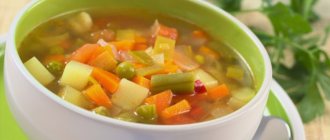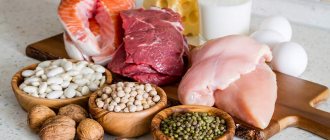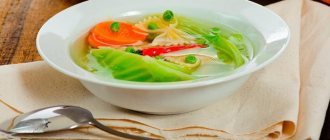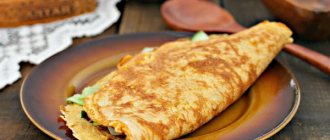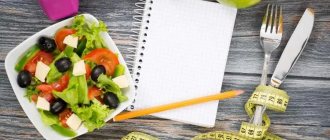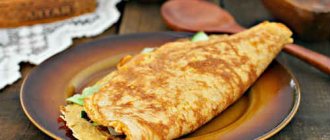It is difficult to adjust your own diet, taking into account the ratio of proteins, fats and carbohydrates, calorie content and vitamin and mineral composition.
You can simplify the task by using the tables that nutritionists have worked on.
Taking into account the proposed products, you can create a daily diet for adults and children.
Rules for preparation and organization (breakfast, lunch, dinner, snacks)
When creating a menu, you need to have a basic understanding of calories, macro- and microelements. Calories measure the energy we get from food.
And macro- and microelements are components of any biological tissue. Coming to us with food, they participate in all processes of our body. The necessary and constant composition of these elements is regulated by the body.
If there is a lack of elements, the body will signal a desire to eat something (usually a specific one), or it will seek internal strength (“eat” its own reserves of fat or muscle, for example).
If this limit is also exhausted, system malfunctions will begin, which will give rise to diseases.
It is important to take into account not only the products, their composition, combinations, but also the serving size per person with proper nutrition.
Attention! The average formula for the consumption of proteins, fats and carbohydrates looks like this: 1:1:4. As you can see, a significant portion is allocated to carbohydrates. They are sources of energy.
The average calorie intake per day for a person not engaged in active training is 1800-2000 kcal, for men - 2200-2800 kcal.
Calorie content and macronutrient composition can be viewed in this table:
| Products | Quantity, g | Proteins, g | Fats, g | Carbohydrates, g | Energy value, kcal |
| The meat is not fatty when cooked | . | 12-18 | 8-10 | – | 120-150 |
| Fish | 100 | 11 | 2 | – | 50 |
| Cottage cheese | 150 | 20 | 0,7 | 5 | 110 |
| Milk or kefir | 500 | 18 | 18 | 21 | 300 |
| Egg | 1 PC. | 9 | 5 | – | 100 |
| Butter | 15 | 0,06 | 12 | 0,08 | 110 |
| Sour cream | 30 | 0,6 | 8,0 | 1 | 86 |
| Vegetable oil | 20 | – | 18 | – | 190 |
| Sugar | 50 | – | – | 47 | 190 |
You may also be interested in:
Healthy eating: TOP salads
Recipes for healthy sweets
Be sure to check out:
Rules and recipes for a menu with proper nutrition Rules for compiling and a sample menu for a week as part of proper nutrition The meaning and rules for creating a regimen with proper nutrition for a healthy person We create a menu for older people correctly: we take into account the characteristics of the body at 60 and 80 years old
Breakfast - the most important calories
Research suggests that eating a nutritious breakfast speeds up your metabolism throughout the day, helping not only to control your appetite, but also improve the functioning of all body systems². People who eat enough calories at breakfast are less likely to overeat at lunch and dinner.
The recommended calorie content for breakfast is 400 kcal for women and 600 kcal for men. At the same time, proper nutrition involves eating fruits, oatmeal, eggs and natural yogurt - while pastries, bread, sausages, hot dogs and dry cereal for breakfast are not advisable.
// Read more:
- oatmeal for breakfast - what's the benefit?
- how many eggs can you eat a day
- bread - which is the healthiest?
Lunch
If you have breakfast early enough, it is permissible to eat a healthy snack closer to noon - this will help control calories at lunch. The best choice would be sources of fiber and healthy fats of about 150-200 kcal - for example, unsweetened fruit or a handful of nuts.
Also in a diet for weight loss, goji berries, chia seeds or flax seeds can be a second breakfast. They are low in calories, but they create a feeling of fullness and perfectly reduce appetite. They can be taken either in dry form with water (a tablespoon is enough) or in the form of a smoothie.
// Read more:
- Chia seeds or flax seeds - which is better?
- why do you always want to eat?
- smoothie - what is it?
Balance of the daily menu in terms of proteins, fats, carbohydrates
You need to eat as varied a diet as possible. And not only to satisfy taste needs, which is also important, but also to ensure that the body receives everything it needs.
The daily composition of foods should contain 10-15% proteins, 20-30% fats and up to 60% carbohydrates. Read about the norms of BZHU per day for women and men in the article at the link.
When creating a menu, you need to consider:
- Proteins can be obtained from meat, as well as from plant products - buckwheat, beans, nuts, oatmeal. You need to consume 55% animal proteins and 45% plant proteins per day.
- Carbohydrates are simple and complex. Simple ones (sweets, buns, cakes) are best consumed in the morning, they provide quick energy. Complex ones (porridge, pasta, potatoes, whole grain bread) provide a long-lasting effect. If there are few carbohydrates on the menu, there is a high risk of obesity.
- Fats can also be harmful. It is better to give preference to sea fish, nuts and seeds, and unrefined oil. Eliminate margarine and refined oil.
You may also be interested in: Protein day: what you can eat for fasting
Protein food is the basis for the creation of muscle tissue cells; important amino acids are synthesized in them. Proteins do not accumulate or be deposited in the body. They can only come with food.
Important! Vegetables contain proteins, fats and carbohydrates at the same time. There are low-carb vegetables that, even for those losing weight, can be eaten in unlimited quantities.
An alternative way to balance your diet is to find the right combinations of foods with proper nutrition in a special compatibility table.
Calories for lunch and dinner
In most cases, the calorie content of lunch and dinner should be 500-700 kcal. The reason why this figure is exceeded is most often due to free access to food (for example, a buffet) - this is why it is important to learn to control portion size and not fill your plate over and over again.
As for proper nutrition recommendations, the best option for lunch would be a combination of protein sources (meat, chicken, fish) with whole grain cereals and vegetables. For dinner, it is recommended to eat more green vegetables - reducing pasta, sources of starch (such as potatoes) and animal fat.
Excessive consumption of fast carbohydrates for dinner is closely associated with disturbances in the production of insulin - provoking the development of diabetes mellitus. In addition, the habit of making dinner the largest meal of the day (and consuming more than 1000 kcal) quickly leads to excess weight gain.
// Read more:
- glycemic index of cereals
- fiber rich foods
- drying for women - menu by day for the week
Energy balance: are calorie tables necessary?
Calorie content is an important indicator. The amount of energy that must be supplied to the body is equal to that consumed – no less and no more.
If you want to lose weight, less. When creating a menu for breakfast, lunch and proper dinner, you need to check all the products with the calorie content (kcal) table.
It is worth considering the following points:
- The calorie content of water, tea and coffee without sugar is not taken into account. There are simply no calories. But if you added honey, sugar, milk, you need to calculate what energy value the drink acquired.
- For complex and multi-component dishes, calorie content is calculated based on the calorie content of each component. It's not as difficult as it might seem.
- When you need to fry food in oil, the calorie content of the product is added to the calorie content of the frying ingredient used. To reduce it, it is recommended to use pans with a non-stick surface or simmer, bake, rather than fry foods.
For a woman living an ordinary life, on average, up to 2000 calories per day are needed, and for a man - up to 2500. If we are talking about athletes, the calorie content for a woman can reach 2200 kcal, and for a man - 2800.
To calculate your own calorie consumption, they resort to a simple formula: multiply your weight in kilograms by 24. This consumption applies to a person leading a quiet lifestyle.
When eating high-calorie foods, it is worth increasing the load, that is, “working off” the eaten piece. Energy consumption can be seen in the table:
| Types of activities | Calorie consumption | |
| Kcal/min | Kcal/hour | |
| Walking | 2,3-2,8 | 152-175 |
| Run | 6,3-7,2 | 363-431 |
| Skating | 6,1-7,1 | 365-435 |
| Swimming | 8,3-10,2 | 514-612 |
| Skiing | 5,7-7,1 | 352-427 |
| Badminton | 4,2-5,5 | 263-310 |
| Outdoor games | 3,9-4,7 | 232-280 |
For more information about calorie consumption for various types of activities with tables, see the link.
To determine individual energy consumption taking into account activity, you can use the following formula: multiply the weight in kilograms by 24, and then by another number:
- 1.2 – for obese people leading a measured and sedentary lifestyle;
- 1.4 – for those who visit the gym or sports field two to three times a week;
- 1.5 – for daily exercise;
- 1.6 – for office workers.
Interesting! Mental activity also requires energy expenditure. With average mental activity, 0.25 kcal per minute is spent, and with intense mental stress - up to 1 kcal. It turns out that an intellectual can burn 1.25 kcal in a minute, and 15 kcal in an hour.
What determines calorie intake?
The source of calories in food is its nutrients - fats, proteins and carbohydrates. The most calories are in fats, 2 times less in proteins and carbohydrates. All these nutrients are very important for our body, and it must receive all of them in certain quantities.
The main fuel of our body is carbohydrates; they are easily processed and saturate us with energy. Proteins take a very long time to digest, and fats take even longer and more difficult. The more fat in a product, the higher the calorie content of this product and the more fat the body will not be able to break down, which means it will simply be sent “to the warehouse” - into adipose tissue. Foods containing a lot of carbohydrates can also lead to obesity - if there are too many carbohydrates, then the body does not consume those that it also converts into fat.
The calorie content of food depends on the content of these nutrients and their ratio . If you have correctly calculated the caloric content of your diet and compiled a diet, then you will definitely not go hungry while losing weight, but if when compiling your diet you did not take into account the content of various nutrients in foods, then you may find that your daily calorie intake is already eaten, but still want to eat. For example, the calorie content of your breakfast should be 400 kcal. You can eat a plate of oatmeal with prunes and a glass of kefir, you can eat an omelet of 4 eggs, toast, a slice of cheese, tea and an apple, or you can eat 1 fried pie with potatoes or half a chocolate bar. What will you eat more of? With the same calorie content, food can fill you up in different ways, be harmful or beneficial for the body and for your figure.
Features of healthy food per day for adults and children
Adults and children require different amounts of calories. This table shows how different the energy needs of a child and an adult of different gender are.
| Age (years) | Number of kilocalories | |
| Men | Women | |
| 1-3 | 1300 | 1300 |
| 4-6 | 1800 | 1800 |
| 7-9 | 2000 | 2000 |
| 9-12 | 2250 | 2150 |
| 13-14 | 2500 | 2300 |
| 15-18 | 3000 | 2500 |
| 19-35 | 2600 | 2200 |
| 36-50 | 2400 | 2000 |
| 51-65 | 2200 | 1800 |
| 65 and older | 1900 | 1700 |
Important! Up to 5 years of age, any diet for weight loss is strictly prohibited. Except in special cases as prescribed by a doctor. You just need to eliminate fast food, soda and reduce your consumption of sweets.
From 5 to 9 years old, you can slightly reduce calories by reducing foods with simple carbohydrates. It is better to encourage your baby to move more, enroll him in a sports section or swimming.
From the age of 10, you need to protect your child from spending a long time at the computer, transfer him to a healthy diet, but not deprive him of little joys in the form of sweets.
Three steps to the perfect menu
Step 1. Select products
When you cook your own food, it's easier for you to control the caloric content of your dishes: you know what ingredients you add and in what quantities. Let's see which products are better to give preference to and which ones should be avoided, significantly reduced in quantity or abandoned altogether.
| The right products | Wrong Products |
| Fresh meat: poultry, beef, pork, offal | Marinated meat or fish from the prepared foods department, store-bought minced meat |
| Fresh fish and seafood | Smoked meat or fish |
| Seasonal vegetables, fruits and berries | Ready-made semi-finished products: frozen cutlets, dumplings, dumplings, pancakes, ready-made set meals |
| Fresh herbs | Frozen fruits, vegetables and berries, canned products |
| Dairy and fermented milk products without additives and with a short shelf life | All dairy and fermented milk products with flavoring additives: yoghurts, curd desserts, curd cheeses |
| Cereals that require long cooking | Porridge, pasta and other instant side dishes |
| For dressing salads and other dishes: sour cream, vegetable oils, vinegar, soy sauce | Mayonnaise, ketchup, ready-made sauces for meat, fish, pasta, vegetables |
| Butter | Margarine, rendered animal fat, lard |
| Marshmallows, marshmallows, dark chocolate, fruit jelly | Sugar, candy, milk chocolate, sweet pastries |
| Dried fruits, nuts, honey | Alcohol, especially beer and ready-made cocktails |
| Bread: whole grain, bran, rye, wholemeal, sprouted wheat | White bread |
| Green tea, natural coffee | Instant coffee, sweet soda |
Don't be discouraged if you can't do everything at once. Gradually, you will learn to choose the products you need, refuse fatty store-bought sauces, and prefer oven-baked meat with mustard or fish with a sprig of rosemary and lemon to ready-made dumplings.
Buzhenina
Using the right ingredients, you can prepare delicious and varied dishes. And even homemade sausage, smoked meat, sweets, and baked goods.
Step 2. Proteins, fats and carbohydrates: for what and how much?
Any diet limits the consumption of carbohydrates, fats and, less often, proteins, from which we get calories - energy to maintain our vital functions. Fat is the most caloric: 1 gram of fat (any kind) contains 9 kcal. Proteins and carbohydrates - 4 kcal per 1 gram.
Carbohydrates
(bread, cereals, vegetables) are necessary for the body primarily as fuel, as a means of obtaining energy to maintain our vital functions. The fewer carbohydrates you consume, the less active you become.
Squirrels
(meat, poultry, offal, fish) is a building material for the muscles and cells of the body. If you cut too much protein in your diet, you will never get a beautiful, toned body.
Fats
important for the absorption of fat-soluble vitamins A, D, E, K. By eating only low-fat foods, you risk causing health problems. For example, calcium is absorbed in the presence of vitamin D. Vitamin D, in turn, is absorbed with the help of fats. It is advisable to consume fats from morning to lunch. In the evening, fats should be discarded or consumed in very small quantities (for example, seasoning a vegetable salad with sour cream or adding a drop of vegetable oil to it).
To lose weight without harm to your health, your diet should contain about 50% carbohydrates, 30% proteins and 20% fats
. With this balance of proteins, fats and carbohydrates, you will lose excess fat. If you want to speed up the process a little, reduce the amount of carbohydrates to about 40%, and on the contrary, increase the amount of proteins to 40-50%. According to doctors' recommendations, the amount of fat should not be lower than 10-15%.
Step 3. Create your own menu: we won’t give dinner to the enemy
8 proven tips that always work will help you with this.
Tip 1.
Never skip breakfast. Breakfast should be light, but at the same time fill you up and energize you. The calorie content of breakfast is approximately 30% of your daily diet. It is best to eat carbohydrate-rich foods in the morning.
The best breakfast
it's porridge.
With porridge you can eat fruits, dried fruits, bread, butter, cottage cheese, cheese, eggs, boiled meat, nuts, honey, milk, tea, coffee. You can safely pamper yourself with your favorite sweets for breakfast or during the first half of the day.
Tip 2.
Don't skip lunch. Lunch should be complete, calorie content should be about 40% of your diet, and include proteins and carbohydrates in approximately equal proportions.
What to eat for lunch:
first courses, vegetables with meat or fish, vegetables with potatoes, bread, sour cream, porridge with vegetables, meat or fish, salad, pasta, legumes.
Tip 3.
Don't skip dinner. If you didn’t manage to have dinner on time, be sure to eat a light dinner a little later. The last meal should be 4-5 hours before bedtime.
Perfect dinner
- this is meat or fish (protein) with vegetables. You can stew vegetables, make a salad, and prepare various casseroles with meat or fish. Moreover, protein should predominate. Evening calories account for about 20%.
Tip 4.
Always have a snack between meals. 8-10% of your daily calories should come from snacks.
What to eat for a snack in the morning:
fruits, crackers with tea, a handful of dried fruits or berries, nuts, honey.
What to eat in the afternoon:
vegetables, cottage cheese, fermented baked milk, yogurt, kefir, cheese. There is a very simple, tasty and satisfying salad (any proportions): cut fresh tomatoes into small cubes, add cottage cheese, chopped herbs, a little salt and a drop of olive oil. Mix all ingredients. Dill works very well for this salad, and basil is even better. Having a snack with this salad will perfectly satisfy your hunger. The same salad, only without oil, is perfect for dinner.
Tip 5.
Be sure to drink clean water throughout the day.
Water is necessary for normal digestion, which means that everything will be fine with your metabolism. It is better to drink water 20-30 minutes before meals, and no earlier than 1 hour after meals.
Tip 6.
If you don't have the opportunity to eat normally during the day, stock up on small plastic containers for each meal. At first it will not be very convenient for you to collect them and carry food with you. But very soon you will get used to the fact that you always have a healthy snack at hand and do not need to go to the supermarket during your lunch break to buy cutlets from the culinary section.
Tip 7.
Don't overeat at night, but don't go to bed on an empty stomach either. About an hour before bedtime, drink a glass of kefir, tea with lemon balm or mint. If you're hungry, eat a raw carrot, cucumber, celery, green apple, or a piece of cheese. In case of severe hunger (this happens at first, while you get used to a new way of eating), boiled meat helps out very well. There are no carbohydrates in it, and you don’t have to be afraid that you will put on something in the form of an extra kilogram.
Tip 8.
Don't overeat, even if it's your favorite treat. Do not eat until you feel heavy and short of breath. We often ask ourselves the question: how much should we eat at one meal? The fact is that all people are individual. The main cause of excess weight is banal overeating. A distended stomach can accommodate two, three or more servings. For such a person, not overeating means eating a little less than usual and feeling slightly hungry after eating. So start by reducing your portions.
limit portions
An acceptable serving size for the average person is about 200-300 ml. It is important to consider the calorie content of a serving. For example, 100 grams of fish soup contains from 30 to 50 kcal, and 100 grams of cervelat contains about 300 kcal.
Armed with knowledge, start planning your diet. Now only your favorite dishes and minus excess weight. Let's leave starvation diets in the past and start a new day with a smile!
Advice from professionals
Nutritionists offer various options for improving your figure and improving your health through rational food consumption. From this variety you can choose what is most acceptable.
Nutritionist and author of the book “Minus 60” Ekaterina Mirimanova
When creating a menu, this specialist advises including various goodies in the menu in the first half of the day before 12 o’clock. Breakfast can be carbohydrate-protein, and second breakfast can consist of simple carbohydrates.
You can eat the whole cake if you wish, it will not affect your figure. At lunch it is a little stricter - until 14:00 you can eat meat with a side dish of rice or other grain product. But no more sweets. Just an unsweetened fruit.
From 14:00 to 16:00 and fruit is prohibited. It's better to eat a cup of fresh vegetable salad or a handful of nuts. Tea and coffee only without sugar. And until 18:00 an even more strict diet. You can eat protein or carbohydrate foods, but not together. No sweets. After 18:00 try not to eat at all.
Moscow nutritionist, author of a rational nutrition system Anatoly Volkov
When creating a menu, he recommends including those foods that the body “loves.” Nutritionists will help you identify them; there are special tests.
His system involves minimizing the heat treatment of foods, not eating carbohydrate and protein foods together, and not confusing hunger with the desire to drink.
Before you eat something because you feel hungry, you need to drink a glass of water. If hunger does not go away after an hour, you can eat.
Famous metropolitan nutritionist Albina Komisarova
This specialist is against any diets. She believes that losing weight is a secondary goal. And health comes first. Therefore, you need to eat everything, but in moderation. She recommends porridge for breakfast; it keeps you full for a long time.
Eat sweets in the morning. In the morning on an empty stomach, drink a glass of water with lemon juice. In the afternoon - soup, meat with side dishes, salad. In the evening - protein food, but light. Many show business stars have already followed her advice and achieved the desired result.
You may also be interested in: Simple and effective diet “Plate Rule”
Diet for weight loss (with an example menu for 1600 kcal)
Diet is extremely important for losing weight. It helps you become disciplined and selective when choosing foods. The main condition is that this mode is comfortable for you. Why do you think people quit strict diets? Because they are inconvenient. An adequate calorie deficit and a comfortable diet consisting of your favorite healthy foods are the most successful weight loss strategy.
How often should you eat?
The distribution of foods throughout the day should be convenient for you, but the calorie deficit must be maintained. The optimal period of time between meals is 3-4 hours.
If you have a lot of excess weight and your calorie deficit exceeds 1500 kcal, then the best option would be split meals 5-6 times a day. If you are not overweight and your caloric deficit is below 1500 calories, then consider eating 3-4 times a day.
People who are heavier often have increased insulin secretion and difficulty controlling their appetite and will benefit more from smaller meals. It will allow you to divide your daily caloric intake into a large number of meals, thereby maintaining satiety, normal sugar levels and avoiding overeating. But splitting 1300-1400 calories into 5-6 meals and eating in tiny portions will not be easy.
What should breakfast be like?
Breakfast sets the tone for the whole day. After a long period of overnight hunger, the body needs nutrients. Having the right breakfast helps control your appetite throughout the day. At night, the body reduces insulin secretion, and now imagine what will happen if you eat a large portion of carbohydrates in the morning - a high glycemic load, a rapid rise in blood sugar, a surge in insulin. The slower carbohydrates are digested, the smaller the sugar spike will be. Protein, fats and fiber help slow down the absorption of carbohydrates.
Therefore, protein must be present in breakfast - at least 20 g. This is also due to the fact that the last meal of protein food was yesterday. When the body does not receive “building material” for a long time, it begins to use internal reserves - to destroy its own muscles.
A complete breakfast can be protein-carbohydrate or protein-fat. A protein-carbohydrate breakfast is suitable for people who are most active in the first half of the day. They work in mobile work or train. A protein-fat breakfast is suitable for people who are not used to eating in the morning, follow a low-carbohydrate diet, or are inactive in the morning.
Examples of a successful breakfast
10 minutes after breakfast you need to take vitamins and a fish oil supplement.
What can you eat for a snack?
The purpose of snacking is to maintain moderate blood sugar levels and avoid overeating and discomfort. It should include proteins and fiber-rich carbohydrates.
Examples of a successful snack:
- Whole grain bread with cream cheese;
- Vegetable salad with chicken breast and low-fat cheese;
- Cottage cheese with berries or fruit;
- Vegetable sticks and Greek yogurt sauce.
What should lunch be like?
Lunch is the largest meal of the day. By lunchtime you've already worked up an appetite, so the main task is not to overeat and ensure long-term satiety. For it, choose complex carbohydrates, proteins and vegetables. If you eat first courses, then consider the amount of carbohydrates in them. For example, pureed pea soup contains much more carbohydrates than light vegetable soup without potatoes. There is no need to add additional carbohydrates to it. Aim for 20-30 g of protein, 10-15 g of fat and 30-40 g of carbohydrates. Remember, you must fit within the framework of your balanced KBZHU.
Examples of a successful lunch
With the first course:
- Pea soup, skinless chicken drumstick, fresh vegetable salad with butter;
- Borscht with potatoes, toast made from bran or whole grain bread, vegetable stew with lean meat.
Without first course:
- Brown rice with chicken and vegetables;
- Buckwheat porridge with baked lean fish and vegetable salad;
- Durum wheat pasta with lean meat and fresh vegetables.
Nutrition before and after training
Most people exercise after work, but not everyone has time to eat before training and make the big mistake of going to the gym hungry. Fatigue accumulated during the day and low blood sugar levels due to a long period without food will not allow you to carry out an intensive exercise. If you are doing strength training in the gym or with barbells and dumbbells at home, then you need to eat 1.5 hours or have a light snack 30 minutes before it starts. If you're doing a cardio workout or doing a video workout at home, you don't need to have an extra snack before your workout.
Examples of pre-workout meals
If you can eat normally in 1.5 hours:
- Baked potatoes and baked lean fish with vegetables;
- Sandwich made from whole grain or bran bread with chicken fillet and herbs.
If you can have a snack in 30-40 minutes:
- Sweet and sour fruit (apple, orange, pineapple, pear or berries) and Greek yogurt;
- Sweet and sour fruit and a portion of protein.
If you're hungry before a cardio workout, you can snack on fast-digesting proteins 30 minutes before:
After training, you need to eat within an hour. If you are going straight home, then just having dinner is enough, but if after training you have some meetings and the next meal will not take place soon, then you should drink a portion of protein. You will satisfy physiological hunger and create favorable conditions for muscle recovery.
What should dinner be like?
The ideal dinner is light, since most people are inactive in the evenings and spend them at home. An exception may be people who have a light dinner that makes them wake up at night and sweep away the entire contents of the refrigerator. For such people, nutritionists recommend having a light breakfast and a hearty dinner within the daily caloric intake. The composition of a standard dinner is protein and carbohydrates from vegetables.
Examples of a successful dinner
- Baked fish of moderate fat content and blanched vegetables;
- Stewed liver and stewed vegetables with butter;
- Omelette and vegetable salad.
What can you eat before bed?
The last meal should take place no later than two hours before bedtime. Choose light, protein-rich foods. Fermented milk products are ideal for a late snack; they will take care of your muscles and intestinal microflora during night hunger.
Main conclusions
The preparation of a daily diet must be correlated with a table of calorie content and macronutrient content.
To achieve health, harmony and beauty, you should plan the menu for the day and week, write it down in a notebook, even hang it in a visible place - on the refrigerator.
A balanced and healthy diet includes a wide variety of foods and dishes, so you don’t have to go hungry. And if you feel hungry, you should drink water first.
Perhaps this is a false urge, which means there will be fewer snacks between main meals, and therefore fewer calories. For your figure and health, all this is only beneficial.
